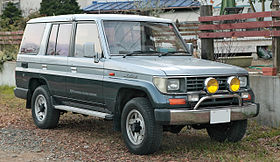
Toyota Land Cruiser Prado J70 1990 - 1996

In April 1990, a new Land Cruiser, the Prado, was introduced.
Prado Predecessor (J70: 1984–1990)
| J70 | |
|---|---|

Land Cruiser 70 Light (LJ71G, Japan)
|
|
| Overview | |
| Production | 1984–1990 |
| Powertrain | |
| Engine |
|
| Transmission | 5-speed manual |
First developed as the light-duty vehicle of the 70 Series, in November 1984. Available only in short body with options for soft top or hard top (metal top). Names like Land Cruiser II, Land Cruiser, and Bundera were made for these "light duty" Land Cruisers. The Bundera was a short wheelbase—being 2,310 millimetres (90.9 in)—with two doors, a plastic top, and barn doors at the rear. There were three options for the engine, the 2.4 L (2366 cc) 22R petrol engine and 2.4 L (2446 cc) 2L and 2L-T diesel and turbocharged diesel engines. Transmission for the petrol engine is the G52 type while the diesels used the R150 and R151 types. These were the same engines and transmission used in 4Runner, in cooperation with Hino.
First generation (J70: 1990–1996)
| J70 | |
|---|---|

Toyota Land Cruiser Prado semi long (LJ78G, Japan)
|
|
| Overview | |
| Production | 1990–1996 |
| Powertrain | |
| Engine |
|
| Transmission |
|
| Dimensions | |
| Wheelbase | 2,730 mm (107.5 inches) |
| Length | 4,585 mm (180.5 in) |
| Width | 1,690 mm (66.5 in) |
| Height | 1,885 mm (74.2 in) |
| Kerb weight | 1,890 kg (4,167 lb) (2L-TE) |
In April 1990, a new type, the Prado, was introduced, with a redesigned front grille, front fenders, engine hood, and head lamps. At the same time, names like Land Cruiser and Land Cruiser II were still used in other parts of the world besides Japan. Prado means meadow or field in Portuguese. Despite a body-on-frame design making it highly capable off-road, the vehicle was marketed toward on-road use.
In Japan it came with electronic fuel injection and four speed automatic transmission. The 2.4 L turbocharged diesel engine with 71 kW (97 PS; 95 hp) and 240 N⋅m (177 lbf⋅ft) high torque unit was installed. The line up included 2-door and 4-door versions available in SX, LX or EX (4 door only) grades of trim.
The front suspension was changed to a "shock absorber through spring" design to improve handling. With the touch of a button you could switch between stages of absorber. The 22R petrol engine was upgraded to the 22R-E (electronic fuel injection) engine, the diesel engines were replaced by the 2.8 L (2776 cc) 3L engine, and the 2.4 L (2446 cc) 2L-T turbocharged diesel engine was replaced by the electronically injected 2L-TE turbocharged diesel engine. In 1993, the 22R-E petrol engine was replaced by the 2.7 L (2693 cc) 3RZ-FE petrol engine and the 2L-TE turbocharged diesel engine was replaced by the 3.0 L (2982 cc) 1KZ-T turbocharged diesel engine with aluminium cylinder head. The 1KZ-TE was able to reduce NOx and soot. The dash board was replaced with a new design with minor changes to suspension, brakes, and trim details.
